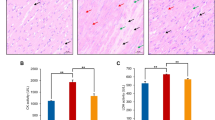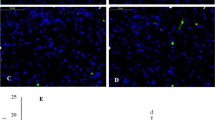Abstract
Selenium (Se) mainly performs its function through Se-containing proteins. Selenoprotein W (SelW), one member of the selenoprotein family, plays important roles in the normal function of the heart. To investigate the possible relationship between Se and SelW for the regulation of oxidative damage in chicken embryo myocardial cells, we treated myocardial cells with Se and H2O2. Then, the levels of lactate dehydrogenase (LDH) and 3,4-methylenedioxyamphetamine in the culture media, levels of SelW, inflammatory genes NF-κB, tumor necrosis factor (TNF)-α, p53, and the cell cycle were analyzed. Furthermore, the correlation between SelW and the levels of these factors was determined. The results indicated that Se treatment increased the expression of SelW (P < 0.05) and caused a downregulation of p53, NF-κB, and TNF-α (P < 0.05). In contrast, H2O2 increased the expression of p53, NF-κB, TNF-α, and LDH (P < 0.05) and induced early cell apoptosis, which was alleviated by treatment with Se. In addition, SelW had a positive correlation with the levels of inflammatory genes investigated. Taken together, our findings suggested that SelW is sensitive to Se levels and oxidative stress, and may play a role in the protective function of Se against oxidative damage and inflammation in chicken myocardial cells.







Similar content being viewed by others
References
Combs Jr GF, Clark LC, Turnbull BW (2001) An analysis of cancer prevention by selenium. Biofactors 14:153–159
Li JL, Gao R, Li S, et al (2010) Testicular toxicity induced by dietary cadmium in cocks and ameliorative effect by selenium. Biometals 23:695–705
Chariot P, Bignani O (2003) Skeletal muscle disorders associated with selenium deficiency in humans. Muscle Nerve 27:662–668
Rayman MP (2000) The importance of selenium to human health. Lancet 356:233–241
Schweizer U, Schomburg L, Savaskan NE (2004) The neurobiology of selenium: lessons from transgenic mice. J Nutr 134:707–710
Kryukov GV, Gladyshev VN (2000) Selenium metabolism in zebrafish: multiplicity of selenoprotein genes and expression of a protein containing 17 selenocysteine residues. Genes Cells 5:1049–1060
Kaur P, Bansal MP (2005) Effect of selenium-induced oxidative stress on the cell kinetics in testis and reproductive ability of male mice. Nutrition 21:351–357
Peng X, Cui Y, Cui W, et al (2009) The decrease of relative weight, lesions, and apoptosis of bursa of fabricius induced by excess dietary selenium in chickens. Biol Trace Elem Res 131:33–42
Green DE, Albers PH (1997) Diagnostic criteria for selenium toxicosis in aquatic birds: histologic lesions. J Wildl Dis 33:385–404
Vega L, Rodriguez-Sosa M, Garcia-Montalvo EA, et al (2007) Non-optimal levels of dietary selenomethionine alter splenocyte response and modify oxidative stress markers in female mice. Food Chem Toxicol 45:1147–1153
Bekaert B, Cooper ML, Green FR, et al (2008) Effect of selenium status and supplementation with high-selenium yeast on plasma homocysteine and B vitamin concentrations in the UK elderly. Mol Nutr Food Res 52:1324–1333
Kryukov GV, Castellano S, Novoselov SV, et al (2003) Characterization of mammalian selenoproteomes. Science 300:1439–1443
Kryukov GV, Gladyshev VN (2004) The prokaryotic selenoproteome. EMBO Rep 5:538–543
Castellano S, Lobanov AV, Chapple C, et al (2005) Diversity and functional plasticity of eukaryotic selenoproteins: identification and characterization of the SelJ family. Proc Natl Acad Sci U S A 102:16188–16193
Zhang Y, Fomenko DE, Gladyshev VN (2005) The microbial selenoproteome of the Sargasso Sea. Genome Biol 6:R37
Papp LV, Lu J, Holmgren A, et al (2007) From selenium to selenoproteins: synthesis, identity, and their role in human health. Antioxid Redox Signal 9:775–806
Han YH, Zhang ZW, Su J, et al (2012) Effects of chicken selenoprotein W on H2O2-induced apoptosis in CHO-K1 cells. Biol Trace Elem Res 147:395–402
Wu Q, Yao HD, Zhang ZW, et al (2012) Possible correlation between selenoprotein W and myogenic regulatory factors in chicken embryonic myoblasts. Biol Trace Elem Res 150:166–172
Ruan H, Zhang Z, Wu Q, et al (2012) Selenium regulates gene expression of selenoprotein W in chicken skeletal muscle system. Biol Trace Elem Res 145:59–65
Lescure A, Rederstorff M, Krol A, et al (2009) Selenoprotein function and muscle disease. Biochim Biophys Acta 1790:1569–1574
Papp LV, Holmgren A, Khanna KK (2010) Selenium and selenoproteins in health and disease. Antioxid Redox Signal 12:793–795
Lobanov AV, Hatfield DL, Gladyshev VN (2009) Eukaryotic selenoproteins and selenoproteomes. Biochim Biophys Acta 1790:1424–1428
Pappas AC, Zoidis E, Surai PF, et al (2008) Selenoproteins and maternal nutrition. Comp Biochem Physiol B Biochem Mol Biol 151:361–372
Walter ED, Jensen LS (1963) Effectiveness of selenium and non-effectiveness of sulfur amino acids in preventing muscular dystrophy in the turkey poult. J Nutr 80:327–331
Scott ML, Olson G, Krook L, et al (1967) Selenium-responsive myopathies of myocardium of smooth muscle in the young poult. J Nutr 91:573–583
Cantor AH, Tarino JZ (1982) Comparative effects of inorganic and organic dietary sources of selenium on selenium levels and selenium-dependent glutathione peroxidase activity in blood of young turkeys. J Nutr 112:2187–2196
Tang J, Tan W, Zhu Y, et al (2012) Effect of selenium on the protection of myocardial cells from injuries induced by overloaded reactive oxygen species, and on the expression of actin in myocardial cells. Wei Sheng Yan Jiu 41(2–5):12
Gu J, Royland JE, Wiggins RC, et al (1997) Selenium is required for normal upregulation of myelin genes in differentiating oligodendrocytes. J Neurosci Res 47:626–635
Ido Y, Duranton A, Lan F, et al (2012) Acute activation of AMP-activated protein kinase prevents H2O2-induced premature senescence in primary human keratinocytes. PLoS One 7:e35092
Cao C, Lu S, Kivlin R, et al (2009) SIRT1 confers protection against UVB- and H2O2-induced cell death via modulation of p53 and JNK in cultured skin keratinocytes. J Cell Mol Med 13:3632–3643
Nagaraju K, Casciola-Rosen L, Lundberg I, et al (2005) Activation of the endoplasmic reticulum stress response in autoimmune myositis: potential role in muscle fiber damage and dysfunction. Arthritis Rheum 52:1824–1835
Chen YW, Nagaraju K, Bakay M, et al (2005) Early onset of inflammation and later involvement of TGFbeta in Duchenne muscular dystrophy. Neurology 65:826–834
Baudy AR, Saxena N, Gordish H, et al (2009) A robust in vitro screening assay to identify NF-kappaB inhibitors for inflammatory muscle diseases. Int Immunopharmacol 9:1209–1214
Qi WN, Chaiyakit P, Cai Y, et al (2004) NF-kappaB p65 involves in reperfusion injury and iNOS gene regulation in skeletal muscle. Microsurgery 24:316–323
Tanabe T, Tohnai N (2002) Cyclooxygenase isozymes and their gene structures and expression. Prostaglandins Other Lipid Mediat 68-69:95–114
Pagmantidis V, Bermano G, Villette S, et al (2005) Effects of Se-depletion on glutathione peroxidase and selenoprotein W gene expression in the colon. FEBS Lett 579:792–796
Kim YJ, Chai YG, Ryu JC (2005) Selenoprotein W as molecular target of methylmercury in human neuronal cells is down-regulated by GSH depletion. Biochem Biophys Res Commun 330:1095–1102
Lag M, Refsnes M, Lilleaas EM, et al (2005) Role of mitogen activated protein kinases and protein kinase C in cadmium-induced apoptosis of primary epithelial lung cells. Toxicology 211:253–264
Yi JH, Park SW, Kapadia R, et al (2007) Role of transcription factors in mediating post-ischemic cerebral inflammation and brain damage. Neurochem Int 50:1014–1027
Yao HD, Liu W, Zhao WC, et al (2014) Different responses of selenoproteins to the altered expression of selenoprotein W in chicken myoblasts. RSC Adv 4:64032
Acknowledgments
This study was supported by the National Natural Science Foundation of China (31272626), the International (Regional) Cooperation and Exchange Projects of National Natural Science Foundation of China (31320103920), the laboratory opening project of Key Laboratory of Myocardial Ischemia Chinese Ministry of Education of Harbin Medical University (KF201009), National Natural Science Foundation of China (31402267), Foundation for Young Talents in Higher Education of Heilongjiang China (UNPYSCT-2015009) and “Young Talents” Project of Northeast Agricultural University (14QC20). All authors have read the manuscript and agreed to submit it in its current form for consideration for publication in the Journal.
Author information
Authors and Affiliations
Corresponding author
Ethics declarations
Conflict of Interest
The authors declare that they have no competing interests.
Rights and permissions
About this article
Cite this article
Liu, W., Yao, H., Zhao, W. et al. Selenoprotein W was Correlated with the Protective Effect of Selenium on Chicken Myocardial Cells from Oxidative Damage. Biol Trace Elem Res 171, 419–426 (2016). https://doi.org/10.1007/s12011-015-0529-7
Received:
Accepted:
Published:
Issue Date:
DOI: https://doi.org/10.1007/s12011-015-0529-7




